Small Dog Surgery: 7 Conditions that May Require an Operation for Your Pooch
Small Dog Surgery is not something anyone wants for their favorite canine, but knowledge is power. Learn ways to help, care, and prevent future problems.
by Dr. Max Spicer Last Updated 02-07-2020
Watching your beloved four-legged friend writhe in pain is one of the most heartbreaking experiences for any pet owner. Despite all the love and care, minor ailments and more serious medical conditions can wreak havoc on your beloved pet’s life.
When visiting the vet for the first time, it’s important to ask the following questions to know about your dog’s current health condition.
- What health issues is your dog at risk for?
- What can you do to prevent them from happening?
- What are the treatments for such conditions?
Your vet will have a wealth of information concerning your dog's health, but it is also a good idea to research your breed and know what type of health conditions are common to the breed. Being prepared and knowledgeable may help you prevent small dog surgery in the future.
Purebred canines are often afflicted with more health problems than mixed breed dogs. As a pet owner, it’s best to take care of your pet’s health to spare yourself from the stress of medical emergencies, not to mention the cost of small dog surgery. This way, you can take preventive measures to ensure your furry pal stays healthy and strong.
To keep illness at bay, information is vital. Below is a list of common health conditions of small dog breeds that you should be mindful of.
Small Dog Surgery: Is Your Dog At Risk?
Seven Conditions
1. Eye Problems
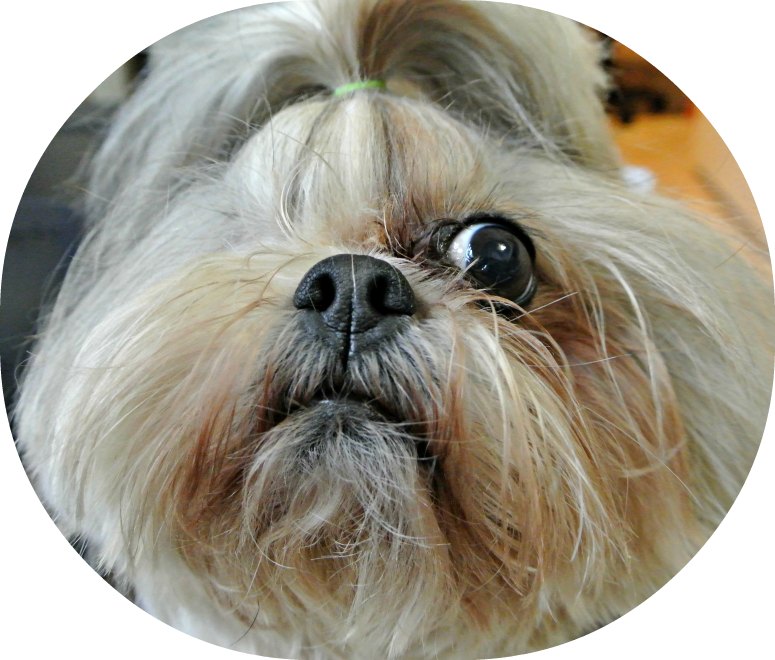 This little girl, Zoey required small dog surgery after she got into a fight with another dog.
This little girl, Zoey required small dog surgery after she got into a fight with another dog.Breeds Often Affected:
Those huge eyes on Pugs, Shih Tzu, and Boston Terriers are a loveable trait that also causes trouble. If they get into an accident or any fight, their eyes are more likely to pop out of their sockets than those of other breeds. They are also at risk for eye problems such as cataracts and dry eyes.
Although many of these conditions may have a genetic component, injury is often the main cause that leads to small dog surgery.
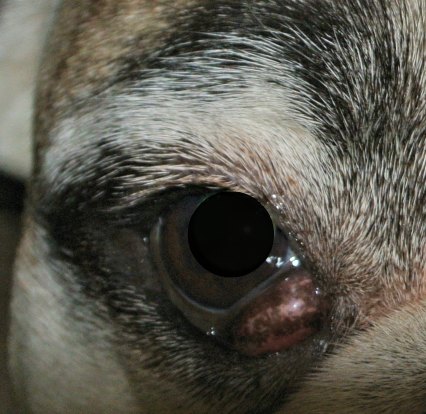 "Cherry Eyes," often require small dog surgery to remove or tack back the 3rd membrane.
"Cherry Eyes," often require small dog surgery to remove or tack back the 3rd membrane.Also, be wary of “cherry eye”. This happens when a dog’s third eyelid (nictitating membrane) becomes red and irritated, and protrudes. Though this condition may not seem to bother your pooch at first, this medical condition should be checked and treated in a timely manner.
2. Slipped Disc
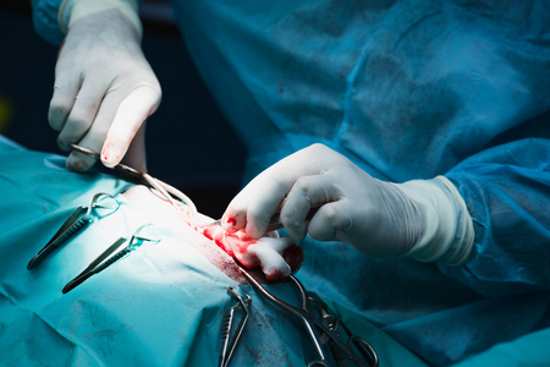 Small Dog Surgery may be avoided by curtailing some of your dog's activities.
Small Dog Surgery may be avoided by curtailing some of your dog's activities.Breeds Affected
Most Dachshunds have a genetic tendency for slipped discs. In comparison to other dog breeds, their risk is 10 times higher. A severe type of disc hernia can result in paralysis. Having an MRI performed on your dog can help confirm the problem.
Although Dachshunds love to jump and run, these physical activities can put an additional strain on their weak spinal cord. Dachshunds who often climb stairs and jump around are more vulnerable to slipped discs and spinal injuries. Don’t let unsafe activities and extra weight strain your dog’s back.
Here are three ways that Dachshunds usually hurt their backs.
- Acute Injury – This is less common and usually happens when the pooch takes a fall and gets into an accident.
- Old Age – Older dogs who didn’t previously have any back problems may still hurt their backs.This is because as they age, the usual wear and tear can still result in spinal injuries.
- Intervertebral Disc Disease (IVDD) – This is quite common and is the result of spinal disk deterioration.
3. Ear Infections
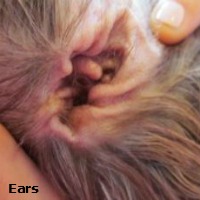 Severe ear infections can result in scratching and head shaking, resulting in injury to the outer ear flap.
Severe ear infections can result in scratching and head shaking, resulting in injury to the outer ear flap.Breeds Affected:
The shape of a Cocker Spaniel’s ears makes the breed vulnerable to ear infections. Ear infections are quite painful and can alter a dog’s behavior. Ear infections are not uncommon in most dogs, so here are some preventive tips to stop ear infections from emerging.
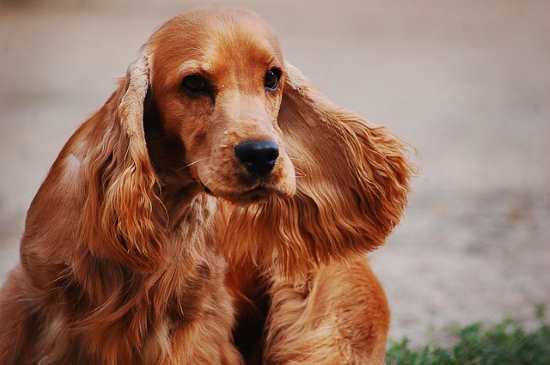
Find out the underlying cause
An ear infection is usually a sign that something is wrong with your pooch. Most ear infections are caused by microorganisms such as bacteria, yeast and ear mites. By ruling out these underlying causes, you can prevent ear infections.
Keep your dog’s ears dry
A warm and moist environment is where bacteria and yeast often thrive in. Most dog ears seem to be a perfect petri dish, and this is especially true for breeds whose floppy ears confine moisture.
For dogs who are prone to ear infections, the best preventive measure is to dry and clean their ears every 5-10 days. After a bath, you can also use a dry cloth to wipe inside the flap, and around the ear canal opening.
Ensure your dog’s ears are clean
Ask your vet for the right ear cleaning solution to use on your pooch, and follow these steps.
How to Clean Your Dog's Ears
- Lift up your dog’s ear flap.
- Soak a cotton ball in the cleaning solution.
- Squeeze the liquid into your dog’s ear canal.
- Gently massage the ear’s base for 20-30 seconds while allowing your dog to shake his head a bit.
- Use soft towels or dry cotton balls to wipe off the remains.
4. Tracheal Collapse
Breeds Affected:
A tracheal collapse is a condition wherein the dog’s windpipe shuts down progressively. Over a period of time, the dog starts suffocating. Signs and symptoms involve your dog exhibiting a strange honking noise usually referred to as “goose honking”.
Dogs who suffer from obesity are more prone to this health condition. It’s essential to maintain your dog at a healthy weight, steer clear of allergens, and prevent your pooch from over-excitement.
Even something as simple as having your dog wear a harness rather than a collar may help prevent future small dog surgery.
5. Luxating Patella
Breeds Affected:
Most toy breeds are no stranger to this condition. Luxating patella is also known as “wobbling kneecaps” where dog kneecaps temporarily go out of place. Symptoms include the dog skipping steps, limping or hobbling.
Taking supplements and minerals can prevent dogs from suffering from this condition by making their bones healthier and stronger.
6.Portosystemic shunt (PSS)
Breeds Affected:
The portosystemic shunt (PSS) or liver shunt is a dog birth defect that affects the blood vessels and portal vein of small breeds. The portal vein cleans toxins in the blood coming from the intestines on the way to the liver. But in PSS, the portal vein doesn’t stop at the liver but retains all the toxins instead.
You’ll start to notice that your dog’s growth is slowing down. Plus, your pooch will be suffering from confusion, and may have seizures due to the improper elimination of toxins. There’s no prevention method for this condition, and your vet will require your pet to undergo surgery.
7. Hair Loss (Alopecia X)
Breeds Affected
Fluffy dogs are prone to Alopecia X. It’s a hormonal condition wherein your dog’s hair falls out. You’ll notice tht there are few hairs on both sides of your canine’s body from the thigh areas to the base of their tail.
Neutering or spaying can help your dog’s hair grow back because of the correction of hormonal imbalance. Consult your vet about melatonin as it may be effective in preventing hair loss.
Now that you know the potential health risks, do all the means necessary to promote your dog’s good health. Don’t let the above health conditions discourage you.
How do you Avoid Small Dog Surgery and Keep Your Dog Healthy?
Dogs are kind creatures that constantly provide unconditional love for their humans. Unfortunately, they don’t live as long as people do.
To return the love they give to you, the best thing you can do is to keep your pooch in great shape by knowing the right dog diet and nutrition.
Below are some tips to help keep your dog healthy and strong.
Quality Food
When a dog is on an optimally nutritious diet, you’ll see indicators of good health in his appearance.
- His coat will be much shinier.
- There will be little hair shedding.
- His eyes will appear brighter.
- His tail will be bushier.
- He will be active and playful.
Make it a habit to read dog food labels. Also, exercise food portion control by following the directions on the packaging as overfeeding your dog can lead to obesity.
Avoid the ingredients below when purchasing dry dog food.
- Animal fat
- Meat by-products
- Artificial preservatives: BHT, BHA or ethoxyquin
- Artificial flavors and colors
- Sweeteners: sucrose, corn syrup, ammoniated glycyrrhizin sucrose
Regular Playtime
Don’t let your pooch sleep all day. Let him play around as part of his daily exercise regimen. Dogs desire regular downtime where they can enjoy and play to their heart’s content.
Playtime is not only fun but it also helps keep your dog healthy. In fact, a long walk or trip to the park with your dog is also great for your heart health.
Adequate Sleep
Every day, dogs doze off on an average of 16 hours. It’s important that you provide your dog with his own comfortable bed where he can recharge and sleep soundly.
Creating an ideal nesting area for your pooch is essential for good quality sleep. Don’t place your dog’s bed in an area that has lots of activity and traffic. Doing so will give your pooch restless nights that will eventually cause stress.
De-stressing
Stress in dogs, as in humans can lead to a host of health problems. Do whatever you can to reduce the stress in your dog’s life by understanding his needs. This includes providing the best care and activities for his enrichment.
Giving a little doggie treat, consideration and kindness go a long way in making your pooch happy. And a happy dog is a healthy dog.
Regular Vet Visits
Visiting a vet clinic is a must to keep a tab on your dog’s health. It’s not easy to pinpoint canine problems without the help of a veterinarian. Even if your dog appears healthy and doesn’t have a medical condition, the vet still has to examine him regularly.
During your visit, the vet will perform a dog physical exam from nose to tail. During this procedure, the vet will check for any internal health issues in your dog. This gives your vet a good idea regarding your dog’s health condition, and to spot early signs of potential health problems. Your vet may be able to help you avoid small dog surgery by finding a problem before it gets bigger.
Be a responsible pet owner and provide the best care, prevention and treatment for your beloved pooch. And whatever the case may be, always remember that in dog health (and health in general), prevention is always better than cure.
Safety First
If you are aware that your dog is prone to injury as is the case with Dachshunds and back problems, you will want to assure that he can't leap from furniture or jump down flights of steps. While heredity plays a part, you may be able to avoid small dog surgery, but a simple management plan.
AUTHOR BIO
Dr. Max Spicer is the Managing Partner and Senior Veterinary Surgeon at The Veterinary Hospital in Dubai. He has taken strides towards providing comprehensive service by hiring veterinarians that are flexible, approachable, and highly specialised in their respective fields. Visit him on Facebook.
About Janice (author and voice behind this site)
Having lived with dogs and cats most of her life, Janice served as a veterinary technician for ten years in Maryland and twelve years as a Shih Tzu dog breeder in Ohio.
Her education includes undergraduate degrees in Psychology with a minor in biology, Early Childhood Education, and Nursing, and a master's in Mental Health Counseling.
She is a lifelong learner, a dog lover, and passionate about the welfare of animals. Her favorite breed for over 50 years has been the Shih Tzu, but she has also lived with Poodles, Maltese, Yorkshire Terriers, Beagles, English Bulldogs, Carin Terriers, and a Cocker Spaniel.
When not writing, reading, and researching dog-related topics, she likes to spend time with her eight Shih Tzu dogs, husband, and family, as well as knitting and crocheting. She is also the voice behind Miracle Shih Tzu and Smart-Knit-Crocheting
Does This Article Deserve Your Thumbs Up?
We always appreciate your support and encouragement. Your thumbs up means so much to us. Please like this article.
If you find this page or any page on Small Dog Place Helpful, or useful in anyway, I'd love it if you would click the small heart found on the bottom right of each page.
You can also share or bookmark this page -- just click on the:

Free Monthly Newsletter
Sign Up for Our Free Newsletter and get our Free Gift to You.
my E-book, The Top 10 Mistakes People Make When Choosing a Dog (and how to avoid them)

